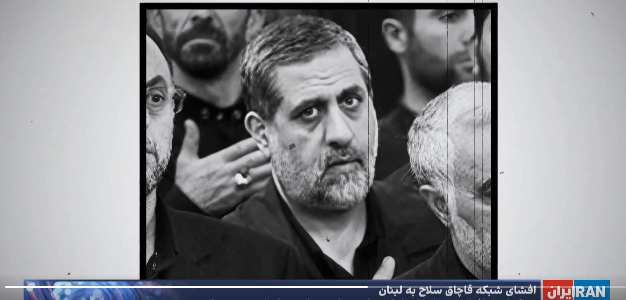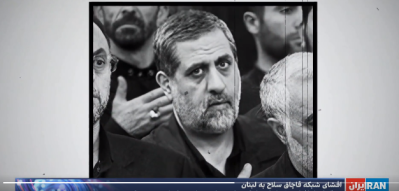In the aftermath of the unprecedented attack by Hamas on Israel, Western intelligence services will be monitoring the movements of multiple Islamic Revolutionary Guard Corps (IRGC) officers, Hamas leadership, and Palestinian Islamic Jihad. While the travel of the commander of the IRGC’s Quds Force, Esmail Ghaani, will be high on the intelligence collection list, there is another IRGC officer who has flown below the radar but whose activity will be pivotal in understanding Iranian strategy: Mohammad Saeed Izadi, the head of the Palestinian Office of the IRGC’s Quds Force in Lebanon.
The Quds Force is a branch of the IRGC charged with external operations in the name of the Islamic revolution. A U.S. official once described it as “a CIA, Pentagon, and State Department all rolled into one.” Izadi is a shadowy figure in the IRGC’s Quds Force, but his fingerprints have been at the center of escalatory actions against Israel over the last decade. In 2015, he planned an attack that was carried out from Syria by Iran proxy Palestinian Islamic Jihad in which rockets were fired on northern Israel. While this operation was seen by Israel as a response to Israeli strikes that killed Hezbollah operatives in Syria, the Israeli security establishment perceived the Quds Force ploy as a clear escalation—morphing from mortar shells regularly straying into Israel into a directed rocket attack. Veteran journalist Ron Ben-Yishai wrote that the 2015 retaliation in Syria, “marked ... the first time a senior Revolutionary Guards official was directly involved in the initiating and directing an action against Israel.”
The U.S. Treasury Department later sanctioned Izadi in 2019 under the counterterrorism authority Executive Order 13224. The U.S. government revealed that as of late 2016 Izadi was liaising with Hamas over financing.
In 2018, Israeli U.N. Ambassador Danny Danon singled out Izadi as spearheading the strengthening of ties between Hamas and Hezbollah, which form the core of Iran’s “Axis of Resistance”—a collection of militias it influences to undertake operations against shared enemies. Danon pointed to high-level meetings between Izadi and Saleh al-Arouri, the pro-Iran deputy head of the Hamas politburo. The following year, the ambassador told the U.N. Security Council “with the help of Saleh al-Arouri, Hamas’ deputy political chief, and Saeed Izadi, the head of the Palestinian branch of the Iranian Quds Force, Iran is trying to turn Judea and Samaria into a fourth military front against Israel.”
Those comments foreshadowed events to come. In 2023, Israel’s internal security service, Shin Bet, announced it had busted residents of the West Bank who were plotting terrorist attacks against the Jewish state and implicated Izadi in the scheme. In this case, Izadi acted through Hezbollah members Huda Mahana and Haj Mohammad Radwan (aka Mohammed Bashir) to recruit these West Bank-based individuals for terror campaigns.
In September, the London-based dissident Iran International TV also implicated Izadi at the center of a plot to smuggle arms from Iran to Hamas via Lebanon. This was yet another sign of Izadi’s ambition to increase coordination between Hamas and Hezbollah. In fact, both organizations employed Mohammad Sarur, a Lebanon-based Hamas and Hezbollah financial operative, to transfer tens of millions of dollars per year from the IRGC’s Quds Force to Hamas’ military wing, the Izz-Al-Din Al-Qassam Brigades, with Hezbollah serving as a middleman.
This record positions Izadi at the heart of the Islamic Republic’s efforts to build its unified Axis of Resistance spanning the spectrum of the militias it supports. This is all directed at the IRGC’s encirclement of Israel from Syria, Lebanon, Gaza, and the West Bank.
During previous conflicts between Israel and Hamas, the IRGC participated in joint operations rooms in Lebanon featuring Hamas operatives, where Izadi likely played a leading role. In Operation Guardian of the Walls in May 2021, the commander of the IRGC’s Quds Force visited the operations center twice during the fighting, according to the editor-in-chief of Al-Akhbar, a pro-Hezbollah outlet.
If, as the Wall Street Journal reported, Quds Force leaders had been holding meetings in Lebanon at least biweekly since August to discuss last Saturday’s attack on Israel, that would be consistent with previous publicly reported patterns of behavior to tighten the cooperation between Hamas and the rest of Iran’s proxy and partner network. The Lebanon-based Izadi was likely at the center of those alleged discussions.
Izadi is not the only individual who is a link between Tehran and Hamas. Under Izadi, open-source information, including from the Alma Research and Education Center, indicates the IRGC’s Quds Force Palestinian Office includes Ali Marshad Shirazi, who also resides in Lebanon; Majid Zaree, responsible for operations with Palestinian militants; and Mostafa Majid Khani, who works on training and instruction with these same organizations. Hamas’ representative in Iran, Khaled Qaddoumi, is a regular point of contact between the terrorist organization and the Islamic Republic.
Hamas’ messaging about Iran’s role has been deliberately confusing and opaque. A Hamas spokesman told the BBC that it had “direct backing” from Iran for the attack on Israel. But later, senior Hamas official Ali Barakeh told the Associated Press that only a select group of Hamas commanders in Gaza knew in advance, especially about the timing, and not even its closest allies had notice of the timing. He also insisted that no one from the Hamas central command or the politburo was in Beirut last week, refuting the Wall Street Journal report. Yet such conflicting statements likely aim to camouflage the Iranian role. Izadi, an IRGC Quds Force officer, is based in Lebanon, as are other Quds Force officers in his orbit. Hamas likewise has representatives stationed in Lebanon—for example Osama Hamdan, who was in Tehran the week preceding the attack, who is also a politburo member.
Operatives like Izadi and Arouri form the backbone of the coordinating function among Hamas and Tehran. Such deep and structural relationships, which have been built over years, at the very least point to prior knowledge and coordination with the Islamic Republic ahead of the Al-Aqsa Storm campaign.
Click here for more coverage of the war in Israel.






Please note that we at The Dispatch hold ourselves, our work, and our commenters to a higher standard than other places on the internet. We welcome comments that foster genuine debate or discussion—including comments critical of us or our work—but responses that include ad hominem attacks on fellow Dispatch members or are intended to stoke fear and anger may be moderated.
With your membership, you only have the ability to comment on The Morning Dispatch articles. Consider upgrading to join the conversation everywhere.